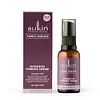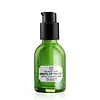What's inside
What's inside
 Key Ingredients
Key Ingredients

 Benefits
Benefits

 Concerns
Concerns

 Ingredients Side-by-side
Ingredients Side-by-side

Water
Skin ConditioningGlycerin
HumectantCaprylic/Capric Triglyceride
MaskingGlyceryl Stearate Se
EmulsifyingDecyl Oleate
EmollientAcacia Senegal Gum
MaskingCoco-Caprylate
EmollientHydrolyzed Rhizobian Gum
Ribose
HumectantAdansonia Digitata Fruit Extract
EmollientHibiscus Sabdariffa Flower Extract
Skin ConditioningTheobroma Cacao Seed Butter
EmollientMacadamia Ternifolia Seed Oil
EmollientArgania Spinosa Kernel Oil
EmollientRosa Canina Fruit Oil
EmollientLycium Barbarum Fruit Extract
AstringentEuterpe Oleracea Fruit Extract
Cetearyl Olivate
Sorbitan Olivate
EmulsifyingSodium Stearoyl Glutamate
CleansingXanthan Gum
EmulsifyingLecithin
EmollientSclerotium Gum
Emulsion StabilisingPullulan
Silica
AbrasiveTocopherol
AntioxidantCitrus Tangerina Peel Oil
MaskingCitrus Nobilis Peel Oil
MaskingLavandula Angustifolia Oil
MaskingVanillin
MaskingVanilla Planifolia Fruit Extract
Skin ConditioningLactic Acid
BufferingPhenoxyethanol
PreservativeBenzyl Alcohol
PerfumingLinalool
PerfumingLimonene
PerfumingWater, Glycerin, Caprylic/Capric Triglyceride, Glyceryl Stearate Se, Decyl Oleate, Acacia Senegal Gum, Coco-Caprylate, Hydrolyzed Rhizobian Gum, Ribose, Adansonia Digitata Fruit Extract, Hibiscus Sabdariffa Flower Extract, Theobroma Cacao Seed Butter, Macadamia Ternifolia Seed Oil, Argania Spinosa Kernel Oil, Rosa Canina Fruit Oil, Lycium Barbarum Fruit Extract, Euterpe Oleracea Fruit Extract, Cetearyl Olivate, Sorbitan Olivate, Sodium Stearoyl Glutamate, Xanthan Gum, Lecithin, Sclerotium Gum, Pullulan, Silica, Tocopherol, Citrus Tangerina Peel Oil, Citrus Nobilis Peel Oil, Lavandula Angustifolia Oil, Vanillin, Vanilla Planifolia Fruit Extract, Lactic Acid, Phenoxyethanol, Benzyl Alcohol, Linalool, Limonene
Water
Skin ConditioningButylene Glycol
HumectantOctocrylene
UV AbsorberEthylhexyl Salicylate
UV AbsorberGlycine Soja Oil
EmollientC12-15 Alkyl Benzoate
AntimicrobialDimethicone
EmollientGlycerin
HumectantButyl Methoxydibenzoylmethane
UV AbsorberPentylene Glycol
Skin ConditioningPolyglyceryl-2 Stearate
EmulsifyingPEG-8 Stearate
EmulsifyingCetyl Alcohol
EmollientDisodium Stearoyl Glutamate
CleansingPhenoxyethanol
PreservativeStearic Acid
CleansingCaprylyl Glycol
EmollientPalmitic Acid
EmollientParfum
MaskingPentaerythrityl Tetra-Di-T-Butyl Hydroxyhydrocinnamate
AntioxidantLinalool
PerfumingAdenosine
Skin ConditioningCitronellol
PerfumingMyristic Acid
CleansingSpiraea Ulmaria Extract
AstringentSodium Hyaluronate
HumectantOrbignya Oleifera Seed Oil
EmollientBuddleja Davidii Extract
Skin ConditioningThymus Vulgaris Flower/Leaf Extract
MaskingLimonene
PerfumingBenzyl Alcohol
PerfumingCrithmum Maritimum Extract
Skin ConditioningEryngium Maritimum Extract
TonicCitric Acid
BufferingLeontopodium Alpinum Callus Culture Extract
AntioxidantXanthan Gum
EmulsifyingWater, Butylene Glycol, Octocrylene, Ethylhexyl Salicylate, Glycine Soja Oil, C12-15 Alkyl Benzoate, Dimethicone, Glycerin, Butyl Methoxydibenzoylmethane, Pentylene Glycol, Polyglyceryl-2 Stearate, PEG-8 Stearate, Cetyl Alcohol, Disodium Stearoyl Glutamate, Phenoxyethanol, Stearic Acid, Caprylyl Glycol, Palmitic Acid, Parfum, Pentaerythrityl Tetra-Di-T-Butyl Hydroxyhydrocinnamate, Linalool, Adenosine, Citronellol, Myristic Acid, Spiraea Ulmaria Extract, Sodium Hyaluronate, Orbignya Oleifera Seed Oil, Buddleja Davidii Extract, Thymus Vulgaris Flower/Leaf Extract, Limonene, Benzyl Alcohol, Crithmum Maritimum Extract, Eryngium Maritimum Extract, Citric Acid, Leontopodium Alpinum Callus Culture Extract, Xanthan Gum
 Reviews
Reviews

Ingredients Explained
These ingredients are found in both products.
Ingredients higher up in an ingredient list are typically present in a larger amount.
Benzyl Alcohol is most commonly used as a preservative. It also has a subtle, sweet smell. Small amounts of Benzyl Alcohol is not irritating and safe to use in skincare products. Most Benzyl Alcohol is derived from fruits such as apricots.
Benzyl Alcohol has both antibacterial and antioxidant properties. These properties help lengthen the shelf life of products. Benzyl Alcohol is a solvent and helps dissolve other ingredients. It can also improve the texture and spreadability.
Alcohol comes in many different forms. Different types of alcohol will have different effects on skin. This ingredient is an astringent alcohol.
Using high concentrations of these alcohols are drying on the skin. They may strip away your skin's natural oils and even damage your skin barrier. Astringent alcohols may also irritate skin.
Other types of astringent alcohols include:
According to the National Rosacea Society based in the US, you should be mindful of products with these alcohols in the top half of ingredients.
Any type of sanitizing product will have high amounts of alcohol to help kill bacteria and viruses.
Learn more about Benzyl AlcoholGlycerin is already naturally found in your skin. It helps moisturize and protect your skin.
A study from 2016 found glycerin to be more effective as a humectant than AHAs and hyaluronic acid.
As a humectant, it helps the skin stay hydrated by pulling moisture to your skin. The low molecular weight of glycerin allows it to pull moisture into the deeper layers of your skin.
Hydrated skin improves your skin barrier; Your skin barrier helps protect against irritants and bacteria.
Glycerin has also been found to have antimicrobial and antiviral properties. Due to these properties, glycerin is often used in wound and burn treatments.
In cosmetics, glycerin is usually derived from plants such as soybean or palm. However, it can also be sourced from animals, such as tallow or animal fat.
This ingredient is organic, colorless, odorless, and non-toxic.
Glycerin is the name for this ingredient in American English. British English uses Glycerol/Glycerine.
Learn more about GlycerinLimonene is a fragrance that adds scent and taste to a formulation.
It's found in the peel oil of citrus fruits and other plants such as lavender and eucalyptus. The scent of limonene is generally described as "sweet citrus".
Limonene acts as an antioxidant, meaning it helps neutralize free radicals.
When exposed to air, oxidized limonene may sensitize the skin. Because of this, limonene is often avoided by people with sensitive skin.
The term 'fragrance' is not regulated in many countries. In many cases, it is up to the brand to define this term. For instance, many brands choose to label themselves as "fragrance-free" because they are not using synthetic fragrances. However, their products may still contain ingredients such as essential oils that are considered a fragrance.
Learn more about LimoneneLinalool is a fragrance and helps add scent to products. It's derived from common plants such as cinnamon, mint, citrus, and lavender.
Like Limonene, this ingredient oxidizes when exposed to air. Oxidized linalool can cause allergies and skin sensitivity.
This ingredient has a scent that is floral, spicy tropical, and citrus-like.
Learn more about LinaloolPhenoxyethanol is a preservative that has germicide, antimicrobial, and aromatic properties. Studies show that phenoxyethanol can prevent microbial growth. By itself, it has a scent that is similar to that of a rose.
It's often used in formulations along with Caprylyl Glycol to preserve the shelf life of products.
Water. It's the most common cosmetic ingredient of all. You'll usually see it at the top of ingredient lists, meaning that it makes up the largest part of the product.
So why is it so popular? Water most often acts as a solvent - this means that it helps dissolve other ingredients into the formulation.
You'll also recognize water as that liquid we all need to stay alive. If you see this, drink a glass of water. Stay hydrated!
Learn more about WaterXanthan gum is used as a stabilizer and thickener within cosmetic products. It helps give products a sticky, thick feeling - preventing them from being too runny.
On the technical side of things, xanthan gum is a polysaccharide - a combination consisting of multiple sugar molecules bonded together.
Xanthan gum is a pretty common and great ingredient. It is a natural, non-toxic, non-irritating ingredient that is also commonly used in food products.
Learn more about Xanthan Gum